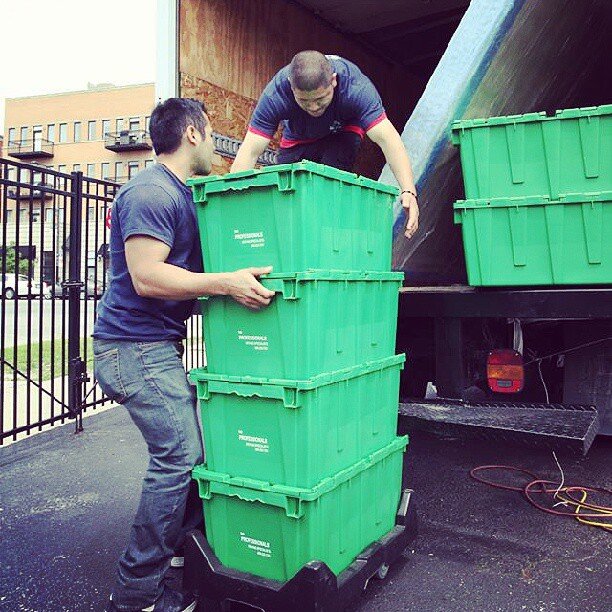Moving to a new home doesn't have to harm the planet. By planning your eco-friendly move well in advance, you can significantly reduce waste and your environmental footprint while avoiding last-minute stress. Starting early gives you time to implement sustainable practices like decluttering unwanted items, sourcing eco-friendly packing materials, and researching green moving companies that prioritize environmental responsibility.
The foundation of a sustainable move begins with thorough decluttering. Take inventory of your possessions and decide what truly deserves to come to your new home. This not only lightens your load but also means less fuel is needed for transportation and fewer materials are wasted on packing items you don't need.
Your choice of packing supplies makes a considerable difference to your move's environmental impact. Instead of buying new cardboard boxes, consider sourcing used packing materials or renting reusable containers. You can also replace conventional packing materials with sustainable alternatives such as newspaper, blankets, and towels for cushioning fragile items, reducing waste while protecting your belongings.
Planning Your Eco-Friendly Move
Effective planning is essential for reducing the environmental impact of your move while keeping stress levels manageable. Early organization gives you time to implement sustainable practices without making hasty, wasteful decisions.
Decluttering for a Sustainable Start
Begin your eco-friendly journey by decluttering responsibly before you pack a single box. Sort your belongings into four categories: keep, donate, sell, and recycle. This process not only reduces what you need to transport but also decreases the carbon footprint of your move.
Consider hosting a garage sale for items in good condition, or list them on online marketplaces. For donations, research local charities that will pick up items directly from your home.
Remember that less weight means less fuel consumed during transportation. Every item you choose not to move represents energy saved and emissions prevented.
Don't rush this process—start at least a month before your move date to ensure you have adequate time to find appropriate homes for unwanted items rather than sending them to landfill.
Selecting Sustainable Packing Materials
Choose environmentally friendly moving boxes instead of buying new cardboard. Options include:
Renting reusable plastic bins
Sourcing used boxes from local stores
Using containers you already own
Asking friends or neighbors for boxes from their recent moves
For cushioning fragile items, avoid conventional bubble wrap and styrofoam. Instead, try these sustainable alternatives:
Blankets, towels, or clothing
Biodegradable packing peanuts
Reusable stretch fabric wraps
Newspaper or recycled paper
When you've finished moving, recycle packing materials properly or pass them on to someone else who's planning a move.
Choosing a Green Moving Company
Selecting the right moving partner can significantly reduce your move's environmental impact. Research companies that prioritize environmental responsibility and have established green practices.
Look for moving companies that use fuel-efficient or electric vehicles to minimize carbon emissions. Many eco-friendly moving companies also utilize biodiesel or other alternative fuels.
Ask potential movers about their sustainability policies. Do they use reusable moving equipment? How do they minimize waste? What recycling practices do they follow?
Request detailed quotes that outline their green initiatives and compare several options before making your decision. Sometimes local movers may have more sustainable practices than national chains.
Remember that choosing a green moving company might cost slightly more, but the environmental benefits make it a worthwhile investment for your sustainable move.
Executing the Move
Now that you've planned your sustainable move, it's time to put everything into action. The execution phase is where your environmental choices make the biggest impact through thoughtful transportation, waste management, and setting up your new space with eco-conscious principles.
Efficient Use of Transportation
Transportation during a move accounts for a significant portion of your environmental footprint. Choose fuel-efficient vehicles whenever possible, or look for moving companies that use biodiesel or hybrid trucks.
Consolidate your move into as few trips as possible by carefully planning your loading strategy. This reduces transportation emissions and saves you time and money on fuel.
Consider coordinating with neighbors or friends who are also moving to share transportation resources. A partially empty truck is less efficient than a full one.
Create a detailed moving checklist that includes transportation logistics to ensure you don't waste fuel on forgotten items or poorly planned routes. Schedule your move during off-peak traffic hours to avoid idling in congestion.
If moving long-distance, explore options for carbon offsets to balance the unavoidable emissions from your journey.
Minimizing Waste on Moving Day
On moving day, keep a sorting system ready for items that need to be recycled, donated, or disposed of properly. Designate specific bins or areas for each category to make waste sorting effortless.
Prepare meals in advance or use reusable containers for food and drinks to avoid single-use plastics and takeout packaging. Keep reusable water bottles handy for everyone helping with the move.
Consider donating unopened non-perishable food items to Move For Hunger, an organization that collects food during moves to reduce waste and help those in need.
Handle e-waste properly by researching local electronics recycling options before moving day. Many retailers and municipalities offer specific e-waste collection services.
Use your phone for digital documentation instead of printing papers. Take photos of furniture assembly, electronics setups, and important documents rather than creating paper waste.
Properly disassemble furniture and keep all hardware organized in labeled reusable containers to avoid losing parts and having to replace entire pieces.
Setting Up an Eco-Conscious Home
Begin your new home setup with a focus on energy efficiency. Install LED light bulbs and smart power strips immediately to reduce unnecessary energy consumption from day one.
Prioritize unpacking your reusable packing materials in a way that allows you to store them properly for future use or pass them along to someone else who's moving soon.
Consider refreshing your space with eco-friendly paint that contains low or zero VOCs (Volatile Organic Compounds) to maintain healthy indoor air quality.
When arranging furniture, think about natural light and airflow to reduce your need for artificial lighting and climate control. Position desks near windows and keep air vents unobstructed.
Set up a functional recycling and composting system right away before waste habits form. Label bins clearly and place them in convenient locations.
Program your thermostat to energy-efficient settings from the start. This green practice establishes sustainable temperature habits in your new home immediately.





